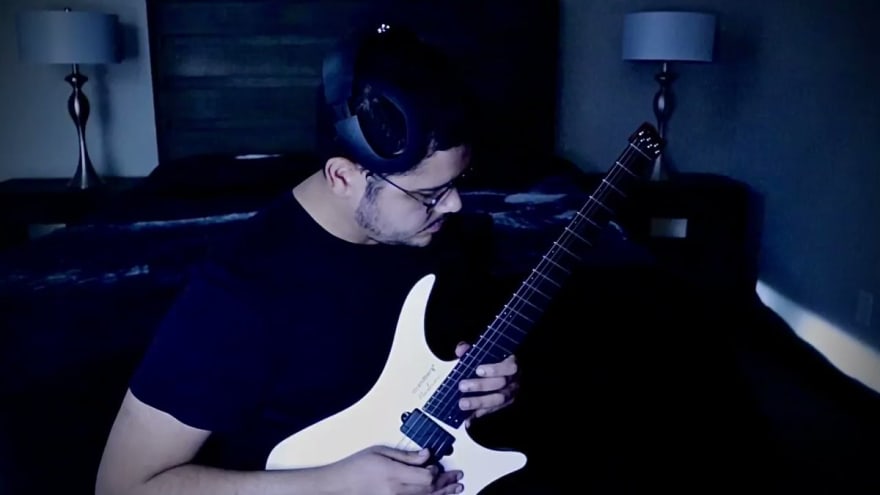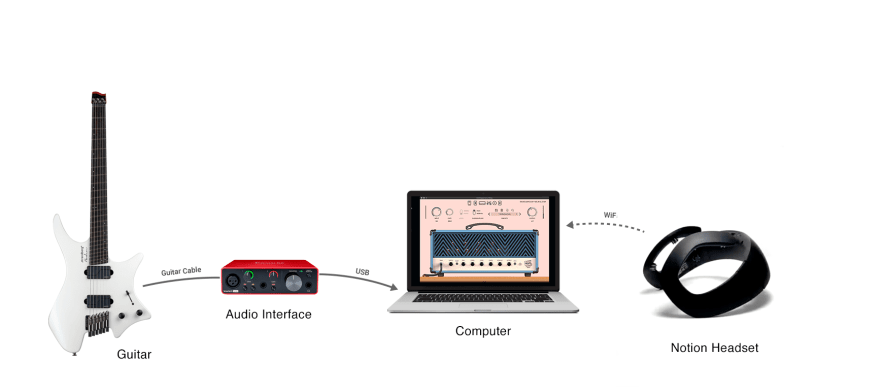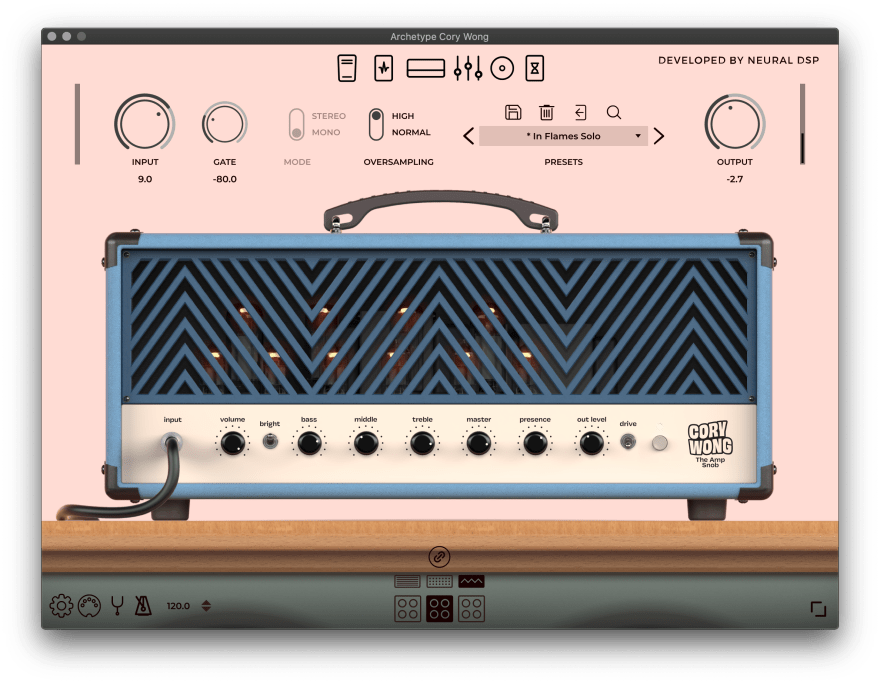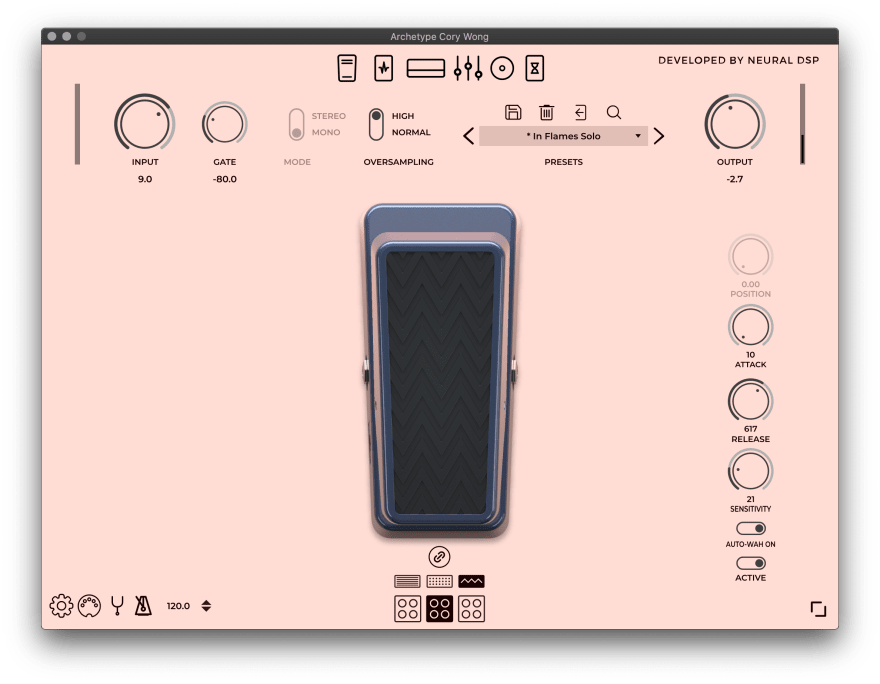= Mind-Controlled Guitar Effects
Traditionally, guitar players have used foot pedals to control their guitar sound. Pedals allow you to change volume, apply effects, modulate sound, and all sorts of awesome sound combinations without using your hands, so you can focus on playing.
Today, we'll be using a Brain-Computer Interface and our thoughts to control the sound of an electric guitar.
Let's do this.
Communication
For this experiment, we won't be using a traditional guitar amplifier, but instead a software-only guitar plugin. So we'll be plugging in the electric guitar to a USB Audio Interface like this one.
The communication from the Node.js app will happen via MIDI which stands for Musical Instrument Digital Interface. For that, we'll use the easymidi library.
npm install easymidi
This awesome package will allow us to send commands to the guitar plugin app via Node.js.
Now, let's create a virtual MIDI output.
import { Output as Midi } from "easymidi";const midi = new Midi("Notion", true);If we run this code, our new MIDI output is ready to be detected by the guitar plugin.
node index.jsGuitar Plugin
I've traditionally used hardware units like the AXE-FX for designing my guitar tone, but lately, I've been playing around with the Neural DSP guitar plugins, and so far I'm loving it.
We'll be using their Archetype: Cory Wong plugin which comes with a neat MIDI utility that we can use map MIDI commands to different sound settings like Presets Changes, Amp Types, Gain, Effects, etc.
You can download a free trial here.
Let's open the standalone plugin and go to Settings (gear icon) located at the bottom left corner of the plugin. Next, let's check the the Notion input under "MIDI Inputs Devices".
The input will show as long as the Node.js app is running.
That's the MIDI device we created in Node with 2 lines of code!
Next, let's go to Midi Mappings by clicking on the icon next to Settings.
I've added 1 MIDI setting and configured it control the strength of the Wah-ng Wah effect based on the value we send from Node.js.
Mind Control
Now let's put everything together.
First, let's install the Notion API.
npm install @neurosity/notion
The Notion API enables full communication between the headset and your apps, in our case Node.js. We'll use it to get real-time feedback based on our cognitive state. For this app, we'll work specifically with the
FocusandKinesismetrics.
import { Notion } from "@neurosity/notion";import { Output as Midi } from "easymidi";import { tween } from "./utils/tween";import { email, password } from "./options";const midi = new Midi("Notion", true);const notion = new Notion();await notion.login({ email, password });notion .predictions("rightFoot") .pipe(tween({ from: [0, 1], to: [0, 254] })) .subscribe((value) => { midi.send("cc", { value }); });Let's break this code down:
- We create a new
Notionand call login using a Neurosity account credentials - Subscribe to motor imagery
predictionsmetrics - Then, we use the
tweenutility function to map focus scores from0to1to their corresponding MIDI value (0-254) AND interpolate all values in between to smooth out the knob change Lastly, we send a
CCMIDI command to the Neural DSP plugin
At this point, the guitar plugin modulates the Wah-ng Wah effect when you think of moving your right foot.
But, what we wanted to change the guitar preset similar to how we would do it with a pedalboard?
For that, we can use Notion's Kinesis API to train our command leftFoot and activate Preset Next via MIDI command by just thinking about your left foot pushing down.
notion .kinesis("leftFoot") .subscribe(() => { midi.send("program", { channel: 0 }); });Conclusion
We, humans, spend most of our lives translating our thoughts into hand movements in order to interact with the world around us.
Would you believe me if I told you the average person presses, taps, and clicks around 3.5 million times a year?
To learn more about the brain, the electrical activity produced by our neurons, and how we can empower the mind, check out my TEDx Talk.
Original Link: https://dev.to/neurosity/mind-controlled-guitar-effects-1b4l
Dev To
 An online community for sharing and discovering great ideas, having debates, and making friends
An online community for sharing and discovering great ideas, having debates, and making friendsMore About this Source Visit Dev To









